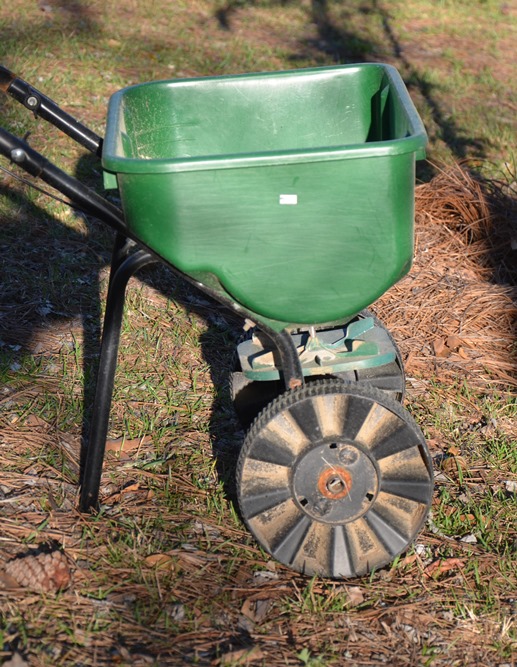
by Les Harrison | Jun 15, 2017
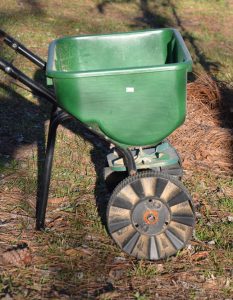
Fertilizer spreader use is in full swing throughout the Florida panhandle
Fertilizing a lawn properly in the summer can enhance the landscape without inducing disease or harming the environment .
One universal activity is seasonal lawn and landscape maintenance. While some consider it a chore, many view it as a means to enhancing their personal environment.
The list of tasks are, for the most part, standard with few surprises. Raking leaves and pine straw, replacing shrubs which did not make it through the winter, and fertilizing the lawn and landscape.
While a routine undertaking, applying fertilizer requires thought and consideration to be effective without negative consequences. It should be a deliberate and well-planned accomplishment which is science based.
The proper selection of a fertilizer should be based on a soil test. Every UF/IFAS Extension Office has supplies for pulling and submitting a soil sample for evaluation.
The results, which can come via mail or e-mail, will tell the homeowner what nutritional deficiencies exist in their lawn and landscape. Based on the type of grass or shrubs, the report will deliver the information on the fertilizer analysis needed for optimum plant performance.
With this information in hand, the homeowner can visit a local retailer who can provide the product which meets the needs of the landscape without wasting excess nutrients. Excess soil nutrients can easily be relocated to bodies of water when storm water washes it downstream.
Homeowners have several types of fertilize from which to choose for use on their lawn. Each has distinct advantages and disadvantages.
Dry blend fertilizer is usually the least expensive and is easy to find in the market place. It is a mixture of minerals and compounds which are combined to produce a particular analysis, such as 10-10-10.
This analysis is ten percent nitrogen, ten percent phosphorus, and ten percent potassium with the remaining 70 percent being micronutrients and inert carrier. Applied correctly, it can be effective at delivering the needed nutrients.
It is most effective when applied several times throughout the growing season. The grass and shrubs will then have a continuous supply of the needed nutrients over time.
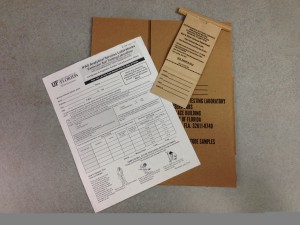
Soil test kit available from your local Extension office. Photo: Mary Derrick, UF/IFAS.
One potential problem with dry blend fertilizer is the particle size of the different nutrients. If irregular, they can separate during transportation to the retailer.
This can be easily corrected by the homeowner. Just pour the contents of the bag into a container and mix using a can or shovel.
Dry slow-release fertilizers are gaining popularity, but they are more expensive. They have a sulfur or polymer coating on the particles which allows for the slow release of the nutrients.
A single application can last for up to six months which frees the homeowner to pursue other activities. The most common use of this product is with shrubs and potted plants.
Liquid fertilizer concentrates are available, but the convenience comes at a high cost. It is easily diluted for use, but uniform application over a large area can be challenging.
No matter which form is used, proper application will grow good results. A healthy and well maintained lawn and landscape leave more time for other springtime pursuits.
To learn more about the fertilizer for your landscape, contact your county agent and refer to this section on our website devoted to lawn fertilization.
by Daniel J. Leonard | May 18, 2017
If you’re like me, growing turfgrass is often more of a hassle than anything else. Regardless of the species you plant, none tolerates shade well and it can seem like there is a never-ending list of chores and expenses that accompany lawn grass: mowing (at least one a week during the summer), fertilizing, and constantly battling weeds, disease and bugs. Wouldn’t it be nice if there were an acceptable alternative, at least for the parts of the lawn that get a little less foot traffic or are shady? Turns out there is! Enter the wonderful world of perennial groundcovers!
Perennial groundcovers are just that, plants that are either evergreen or herbaceous (killed to the ground by frost, similar to turfgrass) and are aggressive enough to cover the ground quickly. Once established, these solid masses of stylish, easy to grow plants serve many of the same functions traditional turf lawns do without all the hassle: choke out weeds, provide pleasing aesthetics, reduce erosion and runoff, and provide a habitat for beneficial insects and wildlife.
The two most common turfgrass replacements found in Northwest Florida are Ornamental Perennial Peanut (Arachis glabra) and Asiatic Jasmine (Trachelospermum asiaticum); though a native species of Mimosa (Mimosa strigillosa) is gaining popularity also. All of these plants are outstanding groundcovers but each fills a specific niche in the landscape.

Perennial Peanut Lawn
Perennial Peanut is a beautiful, aggressive groundcover that spreads through underground rhizomes and possesses showy yellow flowers throughout the year; the show stops only in the coldest winters when the plant is burned back to the ground by frost. It thrives in sunny, well-drained soils, needs no supplemental irrigation once established and because it is a legume, requires little to no supplemental fertilizer. It even thrives in coastal areas that are subject to periodic salt spray! If Perennial Peanut ever begins to look a little unkempt, a quick mowing at 3-4” will enhance its appearance.

Asiatic Jasmine
Asiatic Jasmine is a superb, vining groundcover option for areas that receive partial to full shade, though it will tolerate full sun. This evergreen plant sports glossy dark green foliage and is extremely aggressive (lending itself to very rapid establishment). Though not as vigorous a climber as its more well-known cousin Confederate Jasmine (Trachelospermum jasminoides), Asiatic Jasmine will eventually begin to slowly climb trees and other structures once it is fully established; this habit is easily controlled with infrequent pruning. Do not look for flowers on this vining groundcover however, as it does not initiate the bloom cycle unless allowed to climb.

Sunshine Mimosa
For those that prefer an all-native landscape, Sunshine Mimosa (Mimosa strigillosa), also known as Sensitive Plant, is a fantastic groundcover option for full-sun situations. This herbaceous perennial is very striking in flower, sending up bright pink, fiber-optic like blooms about 6” above the foliage all summer long! Sunshine Mimosa, like Perennial Peanut, is a legume so fertility needs are very low. It is also exceptionally drought tolerant and thrives in the deepest sands. If there is a dry problem spot in your lawn that receives full sun, you can’t go wrong with this one!
As a rule, the method of establishing groundcovers as turfgrass replacements takes a bit longer than with laying sod, which allows for an “instant” lawn. With groundcovers, sprigging containerized plants is most common as this is how the majority of these species are grown in production nurseries. This process involves planting the containerized sprigs on a grid in the planting area no more than 12” apart. The sprigs may be planted closer together (8”-10”) if more rapid establishment is desired.
During the establishment phase, weed control is critical to ensure proper development of the groundcover. The first step to reduce competitive weeds is to clean the site thoroughly before planting with a non-selective herbicide such as Glyphosate. After planting, grassy weeds may be treated with one of the selective herbicides Fusilade, Poast, Select, or Prism. Unfortunately, there are not any chemical treatments for broadleaf weed control in ornamental groundcovers but these can be managed by mowing or hand pulling and will eventually be choked out by the groundcover.
If you are tired of the turfgrass life and want some relief, try an ornamental groundcover instead! They are low-maintenance, cost effective, and very attractive! Happy gardening and as always, contact your local UF/IFAS County Extension Office for more information about this topic!
by Julie McConnell | Apr 7, 2017
It’s really tempting to buy a tree and plant it in the middle of your lawn or directly in front of your picture window, but instead take some time to choose the best spot first. Several considerations such as maintenance and mature size should be taken into account before the site is selected.
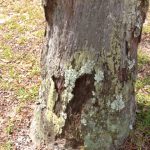
Mowing close to the trunk of this Pindo palm has caused repeated injury to the trunk. Photo: JMcConnell, UF/IFAS
Placing a tree in a lawn area without creating a bed can lead to maintenance issues for both the tree and the turfgrass. It is easy to simply cut out a small patch of turf the size of the rootball and install a tree, however, as the grass grows up towards the trunk over time maintaining that grass will become difficult. It is common to see mechanical injuries to tree trunks because weed eaters or mowers have chipped away at the bark when trying to cut the grass. Other potential problems are irrigation zones calibrated for turf delivering the wrong amount of water to trees and herbicides used on grass that may cause injury to trees.
Over time, as the tree canopy grows, it will create shade and any grass trying to grow in that area will thin and be more susceptible to disease and insect pressure. By creating a large ornamental bed for your tree, you will prevent some pitfalls associated with placing the tree in the lawn.
Another common mistake is planting a tree too close to a house or other structure. It can be difficult to imagine how large a tree will grow at maturity because it is not a quick process. Trees placed close to houses may grow into eaves and shed leaves onto roofs and into gutters. This adds to maintenance and can provide mosquito breeding grounds. Also, some tree roots may interfere with walkways or septic systems and should be sited far enough away to avoid these issues.
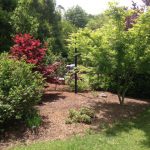
These Japanese Maples are planted in a bed separate from the lawn making care for both plant types easier. Photo: JMcConnell, UF/IFAS
Be sure to research any tree you plan to install to find out ideal growing conditions and mature size. If you plan ahead and use good maintenance practices, a tree can become an valuable part of your home landscape to be enjoyed for years to come.
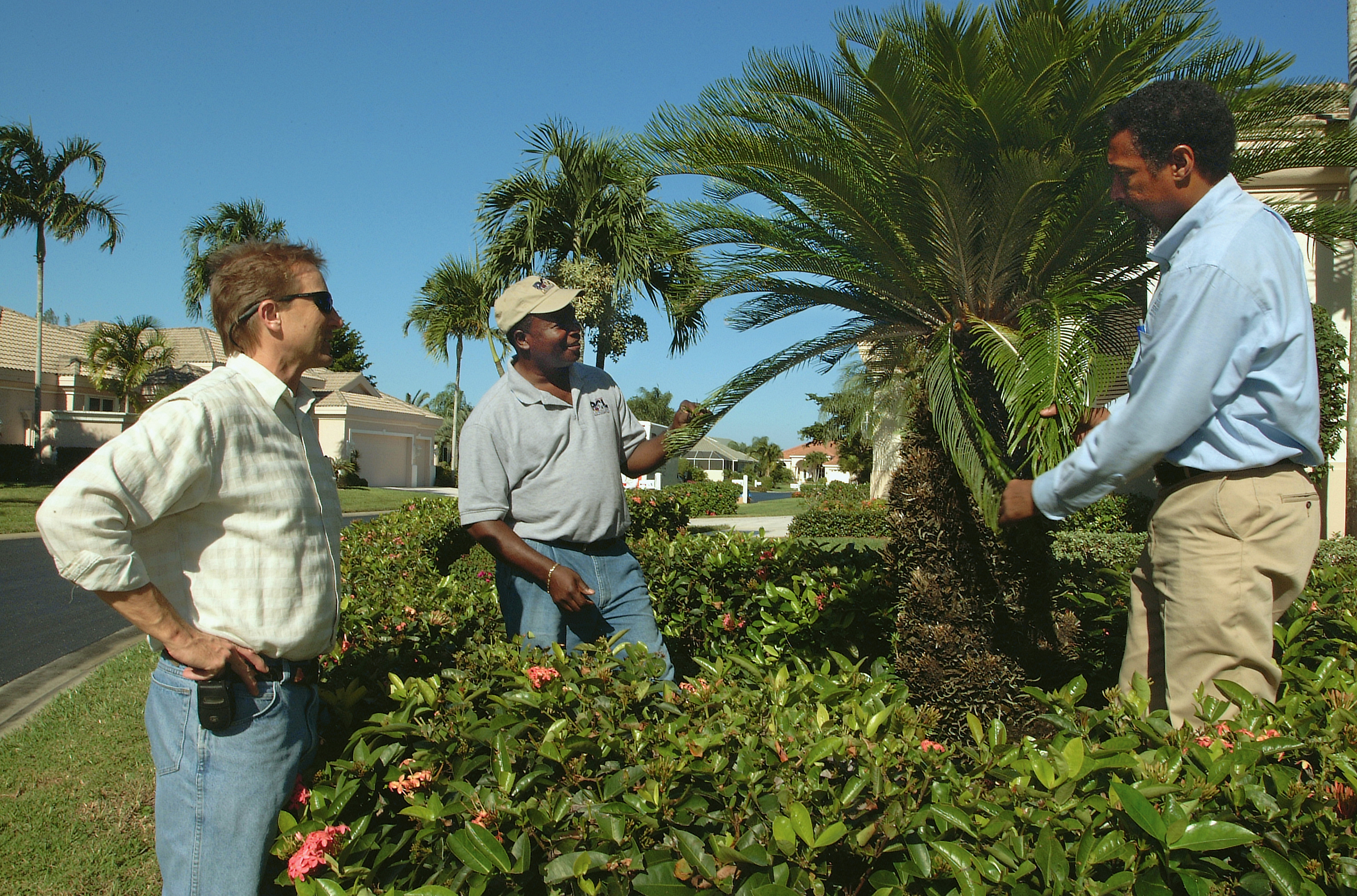
by Blake Thaxton | Mar 9, 2017
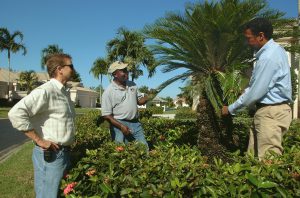
UF/IFAS File Photo
Lawns in northwest Florida are really starting to get going early this year. It is early March but feels much later in the year and many feel behind on their lawn maintenance and various other landscape chores. Maybe it is time to think about hiring a lawn maintenance company to do the job for you. Keep in mind a few tips while trying to decide which company you will hire.
- Lawn Maintenance and Landscape companies are NOT required to have a “professional license” in order to operate their business. This means anyone can start a lawn maintenance company whether they have experience or not. All it takes is a quick visit to the tax collectors office to get a tax receipt. This fact should make you want to go the extra mile to be sure you receive excellent service.
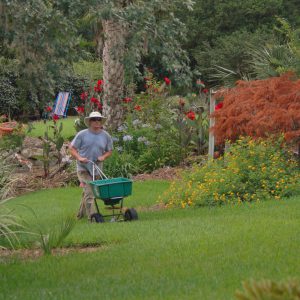
Photo Credits: UF/IFAS File Photo
- Make sure the company chosen has the proper amount of liability insurance.
- There are licenses required for specific services, such as applying fertilizers or pesticides. Check with the company to be sure that the pesticide or fertilizer applicator will be properly licensed to do the job required. Here is a list of licenses to be aware of while choosing a lawn service:
- Receive several quotes from different companies to compare pricing structures and rates. Ask for a very detailed quote. Communicate your needs accurately. Some companies will be better suited for a simple “mow and blow” job while others specialize in a full service job.
- Interview the company and be sure they follow University of Florida recommended mowing heights, fertilization rates, etc.* Quiz them on the subject to be sure they are familiar with properly maintaining landscapes.
There are a lot of really good Landscape and Lawn Maintenance professionals working in Northwest Florida. If you take some time while searching you will find a really good company who can help with beautifying your lawn and landscape.
*Call your local extension office to get the recommended mowing heights, fertilization rates, etc.
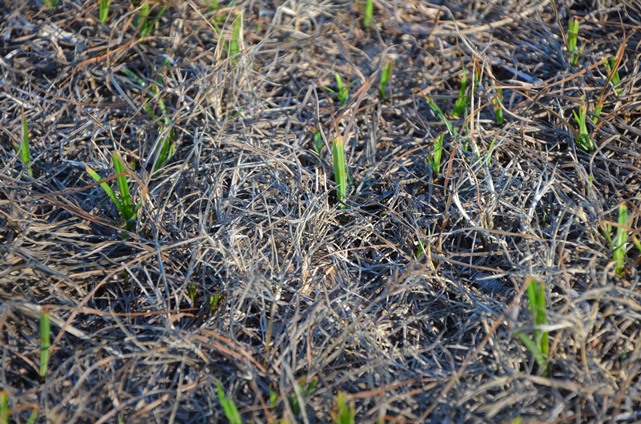
by Les Harrison | Mar 2, 2017
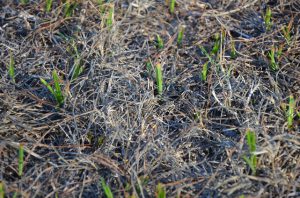
Photo caption: Purple nut sedge is dormant, but quite alive and waiting for warm weather. The best hope for control is to use a pre-emergent herbicide in late February to early March which will prevent this exotic invasive plant from germinating.
Now that March is here the lawn becomes less of an abstraction and more reality.
The lawnmower is no longer silent, meaninglessly taking up space as the grass wakens from its seasonal stupor. Alas, the dormant state has ended as the days are already getting slightly longer.
There is still time to get started with preparations for the ideal spring lawn of 2017. Weather is getting warmer, there is plenty to do.
In addition to doing a soil test, mentioned in previous week’s articles, an accurate weed assessment is also necessary. Though not green and conquering new territory, some of the weeds remain with seed still attached and awaiting distribution.
If the seed are still on the plants, clip the seed pods or remove the plants with the seed intact. Dispose of these properly and do not give them a chance to spread and germinate.
Two notable culprits are nondescript lying dormant waiting for the return of warm, sunny weather. Purple nut sedge and chamberbitter still have countless nutlets and seeds connected to the parent plant.
Purple nut sedge, Cyperus rotundus, grows from every possible sunny location with soil. This non-native plant is a rapidly spreading perennial which will take every opportunity to colonize new locations.
The identifier purple is in its name because there is a purple-tinged section of this sedge where it emerges from the ground. The plant is sometimes referred to as purple nut grass because of its long narrow leaves and its erect growth pattern originating from a nutlike basal bulb.
Chamberbitter, Phyllantus urinaria, is an annual with produces great quantities of seed on the underside of its leaf stems. It will handle full sun or partial shade and quickly form cluster of plants, each contribution seed to the soil.
Areas in the lawn identified as having severe infestations should be marked now for treatment in the near future with a pre-emergent herbicide. This type of herbicide prevents the seed from germinating in the spring.
Purple nut sedge concentrations should be sprayed in late February to early March, and chamberbitter in April since these pest species germinate at different times.
Another winter task is to prepare for seeding bare spots in the lawn. Reading the seed tag attached to the bag should help make the product selection much easier.
Check to confirm the seed has been tested for germination within the year. Also, be sure the grass seed species will grow in Florida.
Sometime generic lawn seed mixes will contain fescue, bluegrass, orchard grass and others turf types which will not grow in north Florida. While they may germinate, their use will only ensure weeds get established for another year.
Lastly, sharpen the lawnmower blade. When the warm weather arrives the mower will be frequently used, but at least the neighbors will be envious of the great green lawn.













